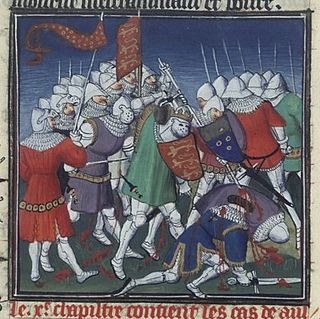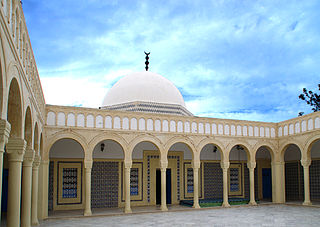Sources
- Bosworth, C. Edmund (2007). Historic Cities of the Islamic World. ISBN 978-9004153882 . Retrieved 26 January 2014.
- Fairbanks, S. C. (2001). "ATĀBAKĀN-E YAZD". Encyclopaedia Iranica, Online Edition. Retrieved 26 January 2014.
Sam ibn Wardanruz was the first ruler of the Atabegs of Yazd dynasty from 1141 to 1188.
Sam was appointed as atabeg by Ahmad Sanjar in 1141, where he married one of the daughters of the Kakuyid Garshasp II. He is described as a weak ruler, and was in 1188 replaced by his more capable brother Langar ibn Wardanruz. Sam later died in 1193.

Year 1095 (MXCV) was a common year starting on Monday of the Julian calendar.

Year 1106 (MCVI) was a common year starting on Monday of the Julian calendar.
Atabeg, Atabek, or Atabey is a hereditary title of nobility of Turkic origin, indicating a governor of a nation or province who was subordinate to a monarch and charged with raising the crown prince. The first instance of the title's use was with early Seljuk Turks who bestowed it on the Persian vizier Nizam al-Mulk It was later used in the Kingdom of Georgia, first within the Armeno-Georgian family of Mkhargrdzeli as a military title and then within the house of Jaqeli as princes of Samtskhe.

In the Battle of Azaz forces of the Crusader States commanded by King Baldwin II of Jerusalem defeated Aq-Sunqur al-Bursuqi's army of Seljuk Turks on 11 June 1125 and raised the siege of the town.

Ahmad Senjer was the Seljuq ruler of Khorasan from 1097 until in 1118, when he became the Sultan of the Seljuq Empire, which he ruled until his death in 1157.

Mahmud II was the Seljuk sultan of Baghdad from 1118–1131 following the death of his father Muhammad I Tapar. At the time Mahmud was fourteen, and ruled over Iraq and Persia.

Abu'l-Abbas Ahmad ibn al-Hassan al-Mustadi' better known by his laqab Al-Nasir li-Din Allah or simply as Al-Nasir was the Abbasid caliph in Baghdad from 1180 until his death. His laqab literally can mean The One who Gives Victory to the Religion of God. He continued the efforts of his grandfather Al-Muqtafi in restoring the caliphate to its ancient dominant role and achieved a surprising amount of success as his army even conquered parts of Iran. According to the historian, Angelika Hartmann, Al-Nasir was the last effective Abbasid Caliph.
Buraq Hajib, also spelt Baraq Hajib, was a Khitan who founded the Qutlugh-Khanid dynasty in the southern Persian province of Kirman the early 13th century after the conquest of the sinicised Qara Khitai by the Mongol Empire. The dynasty founded by Buraq Hajib ended in the 14th century.

The Kakuyids were a Shia Muslim dynasty of Daylamite origin that held power in western Persia, Jibal and Kurdistan. They later became atabegs (governors) of Yazd, Isfahan and Abarkuh from c. 1051 to 1141. They were related to the Buyids.

The Ildegizids, Eldiguzids or Ildenizids, also known as Atabegs of Azerbaijan were a Turkic dynasty which controlled most of northwestern Persia, eastern Transcaucasia, including Arran, most of Azerbaijan, and Djibal. At their extent, the territory under their control, roughly corresponds to most of north-western Iran, most of the regions of modern Azerbaijan and smaller portions in modern Armenia, Turkey and Iraq. Down to the death in war 1194 of Toghril b. Arslan, last of the Great Seljuq rulers of Iraq and Persia, the Ildenizids ruled as theoretical subordinates of the Sultans, acknowledging this dependence on their coins almost down to the end of the Seljuqs. Thereafter, they were in effect an independent dynasty, until the westward expansion of the Mongols and the Khwarazm-Shahs weakened and then brought the line to its close.

Toghrul III was the last sultan of the Great Seljuk Empire and the last Seljuk Sultan of Iraq. His great uncle Sultan Ghiyath ad-Din Mas'ud (c.1134–1152) had appointed Shams ad-Din Eldiguz (c.1135/36–1175) as atabeg of his nephew Arslan-Shah, the son of his brother Toghrul II, and transferred Arran to his nephew's possession as iqta in 1136. Eldiguz eventually married Mu’mina Khatun, the widow of Toghril II, and his sons Nusrat al-Din Muhammad Pahlavan and Qizil Arslan Uthman were thus half-brothers of Arslan Shah, but despite close ties with the Royal Seljuk house, Eldiguz had remain aloof of the royal politics, concentrating on repelling the Georgians and consolidating his power. In 1160, Sultan Suleiman-Shah named Arslan Shah his heir and gave him governorship of Arran and Azerbaijan, fearful of the power of Eldiguz.

The Atabegs of Yazd were a local dynasty, which ruled the city of Yazd from about 1141 to 1319. They succeeded the Kakuyids to whom they were linked by marriage.
Garshasp II, was the last Kakuyid Emir of Yazd and Abarkuh. He was the son of Ali ibn Faramurz.

Mubariz al-Din Muhammad (1301-1363), was the founder of the Muzaffarid dynasty, ruling from 1314 to 1358. He was born to a family of Persians with distant Arab origin, which settled in Khurasan during the Islamic conquest. He was the son of Sharaf al-Din Muzaffar, a servant of the Ilkhanids and on his father's death in 1314 Mubariz inherited his father's offices.

Muhammad ibn Ali ibn Omar ibn Muhammad al-Tamimi al-Maziri, simply known as Al-Maziri or as Imam al-Maziri and Imam al-Mazari, was an important Arab Muslim jurist in the Maliki school of Sunni Islamic Law. He was one of the most important figures in the school and his opinions are well known and respected to this day. Al-Maziri was one of four jurists whose positions were held as authoritative by Khalil ibn Ishaq in his Mukhtassar, which is the most important of the later texts in the relied upon positions of the school. It is for this reason that he is referred to simply as al-Imam within the Maliki school.
The following is a timeline of the history of the city of Yazd, Iran.
Qasīm al-Dawla Sayf al-Dīn Abū Saʿīd Āqsunqur al-Bursuqī, also known as Aqsunqur al-Bursuqi, Aqsonqor il-Bursuqi, Aksunkur al-Bursuki, Aksungur or al-Borsoki, was the atabeg of Mosul from 1113–1114 and again from 1124–1126.
Tughril II was the Sejluk sultan of Persian Iraq briefly in 1132. He maintained power through the support of his uncle, the principal Seljuk sultan Ahmad Sanjar ; when the latter left for Transoxiana to suppress a rebellion in 1132, Tughril II lost Iraq to his rival and brother Ghiyath ad-Din Mas'ud. Tughril II briefly took refuge in the domain of the Bavandid ispahbad (ruler) Ali I in Mazandaran, where he stayed during the whole winter of 1132–1133. He subsequently captured the capital Hamadan, but was stricken with sickness and died on his arrival to the capital, in October/November 1134. Tughril II was survived by his son Arslan, who was raised by the atabeg Eldiguz, who installed him on the throne in 1161.
Husam al-Din Timurtash was an Artuqid emir of Mardin (1122–1154) and ruler of Aleppo (1124–1125).